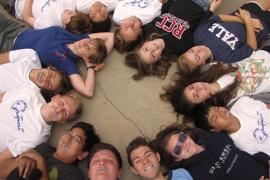"Emily" is a six-year-old camper in the "Jellyfish" group at an East Coast day camp. She is a new camper this year, coming into a group where about 70 percent of the campers are returning. She comes from an upwardly mobile, well-off family who values education and personal achievement. As a consequence, during the school year, Emily is heavily "programmed." As highly successful professionals, both of her parents have demanding work schedules.
The first week of camp, Emily was quiet and tended to suck her thumb, a habit her counselors, in a well-intentioned effort to protect her from possible teasing from her group mates, tried to discourage. By the second week, Emily began to say mean things to one or two of the other girls in her group, announcing to one girl that her bathing suit was "ugly," and that when she wore it, she looked "like an old grandmother with wrinkles." As the week progressed, Emily was telling "secrets" to some of the girls about other girls. By the time I arrived at camp there had been a rebellion by some of the camper moms, all of whom had decided that Emily was a menace to their daughters and that she had to be moved to another group. Emily had been given a two-day "vacation," and when she returned to camp a number of girls expressed a genuine affection for her, saying they had missed her.
Though Emily seemed like a straightforward case of overlyaggressive social behavior, otherwise known as "bullying," I had my suspicions. I decided to observe Emily in her group and get a closer look at her behavior. I caught up with her and her cohorts at a Zumba class. Although she was participating, it was in an absentminded sort of way. She seemed mildly distracted, often looking off in the distance at nothing in particular. When her class was instructed to sit on the dance floor, she responded slowly and with uncertainty, landing awkwardly and immediately complaining to no one in particular that she had "snapped" her leg. (She clearly hadn't.) After a bit of whimpering and some verbal reassurance from her dance teacher that she'd probably just landed hard, she went back into her reverie.
What I saw in Emily was a bright, mildly insecure child with slightly greater than usual dependency needs — those real needs all children have for assurance, warmth, trust, and a sense of wellbeing and security they cannot supply themselves. I "saw" this in her lingering thumb sucking as well as in her complaints about "snapping" her leg. Children with unmet dependency needs often tell us about their bruises and their "boo boos," as if to say, "See! This is where I needed you! And because you weren't there, I got hurt!" Emily's complaint about a "snapped leg" was actually a "coded" statement of her need for nurturing. In her busy family, it would not be a stretch to think she might not get the undivided attention of her parents — parents who likely spend lots of time looking at the screen of their respective BlackBerry devices.
Though the camp could have moved Emily to another group and addressed her mean behavior, doing so would actually have missed the point. Emily seemed to feel insecure in general, and as a new camper, she wasn't sure of her place in this group of many veterans. The more she could be helped to feel secure (especially after being encouraged to give up the self-soothing effect of her thumb-sucking), the less aggressive she would be toward other girls. I say this based on two truths about children:
- The more a child lacks a feeling of security and well-being (the more unmet their dependency needs are), the more they tend to become mean. Think about those homesick campers who eventually quiet down but then become bullies! Their bullying behavior is simply an expression of their anger about being so emotionally hungry and not getting "fed"!
- The more uncertain some girls are about where they stand with other girls in their group, the more they feel the need to control or manipulate that group, usually through rude and mean behavior — telling secrets, excluding others, and starting rumors.
Emily was lucky enough to have a counselor, Laura, who was especially poised, mature, and centered. We gave her the job of occasionally praising Emily, giving her a hug and generally giving her a little extra "tender-loving care." Laura also took Emily and three other girls for one period one day and baked cookies with the four of them — something I call a "play date at camp," because I have discovered that many children today make friends more easily when they are with two or three other children than when they are with ten or fifteen. Once Emily had a "foothold" in her group from the play date, she began to feel more secure. Laura also addressed Emily's mean comments to the other group members by taking her aside when she exhibited behavior like this and having her focus on positive ways to get the girls to like her. As Emily settled down and made more friends, her mean behavior dissipated. She was able to find security without having to be mean to get it.
When I think about Emily and the many other campers whose behavior I have observed at camp over the past few years, I can't help but think that the loss of free, unstructured time has taken its toll on children by depriving them of the kind of problem-solving and socializing skills that come from imaginative play. Some background will help clarify what I mean.
A Toll on Children
In his op-ed piece in the New York Times, David Elkind (2010), author and professor emeritus at Tufts University, reports that a University of Michigan study found that between 1979 and 1999, children in the United States lost over twelve hours of free time a week, including eight hours of unstructured play and outdoor time. One result of this loss has been the gradual disappearance of what child development experts call "the culture of childhood," which consists of things like songs, rhymes, games, ways of choosing sides, superstitions, and other things children share and pass down from generation to generation. Hand-in-hand with the loss of the culture of childhood has been the loss of imaginative play, which is where children learn to invent solutions to problems, practice different outcomes, and work out their differences al l through made-up games and stories.
In the last few years, I have noticed that children in my psychotherapy practice have come into my office with less experience and a lower comfort level with imaginative play. Being able to make up games and stories is the central method of play therapy. I find that I actually have to "teach" kids how to play! This loss of free time and imaginative play has resulted in a serious decline in social skills among children today, including such things as compromising, delaying gratification, cooperating, tolerating frustration, and working through differences.
So what is it children are doing with those twelve hours of lost free and outdoor time? Most sources agree that they are indoors looking at a screen of one kind or another. For example, one-year-olds in the United States watch an average of 2.2 hours of television a day. By the time they are three-years-old, that average rises to 3.6 hours a day. By the time kids are tenyears- old, they are watching an average of 4.0 hours of television a day (Klorer, 2009). And while parents often ban such shows as "South Park," "Gossip Girl," "Jersey Shore," and "Family Guy" — shows where the insults fly, and sex and rude behavior are as common as sunscreen in July — they feel resigned to the fact that their kids will probably end up watching those same shows on their friends' TiVo or some other child's iPhone.
It is no wonder that bullying is on the rise in the United States. With significantly less free playtime to learn to get along with one another, many children are simply mimicking some of the over-stimulating, cruel, mean, sexualized, and violent behavior they are witnessing on all those screens that hold them captive. Indeed, the National Education Association estimates that in the United States, 160,000 children miss school every day because they fear attacks or intimidation by other students (Elkind, 2010).
Parents hear about all of this and end up feeling frightened and helpless. In the past, parents would introduce their children to culture; but these days, parents are trying to shield them from aspects of a culture they can't control. In fact, before we as professionals judge parents for being over-involved with their children, we should first understand that parents today feel powerless about protecting their children from the adverse effects of all those screens. Parents know their children text too much (an average of 3,600 texts per month by thirteen- and fourteen-year-olds). They are mortified at the thought that their child might be one of the 22–33 percent of thirteen- to seventeen-year-olds who are thought to be "sexting" (sending a nude photograph of themselves via text to a boyfriend or girlfriend) (Center on Media and Child Health). Most parents even know that the violent and sexual content of Web sites, television shows, DVDs, and video games — which is al l now avai lable on today's cell phones — is causing an increase in the violent or inappropriate behavior of children in general (just not their child, of course!). What they don't know is that by watching the content from all these screens, children make much less eye contact with one another, are over-stimulated, less resilient, and more confused about boundaries and about what is appropriate than ever before.
Case in point: At a co-ed resident camp I visited this summer, a twelve-year-old girl could not understand what was wrong with her explaining (in exquisite detail) to her alternately enthralled and appalled cabin mates the proper technique for having oral sex with a boy. She explained to her mother on the phone that she felt she had been "singled out" by her counselors. Her defense was that "Everyone talks about this — what's the big deal?" Indeed, she had posted a message on her Facebook wall earlier that spring about how one went about having oral sex in a car. This posting later appeared on the Facebook page of a male counselor who, it came to light, had casually "friended" her and several other girls in her age group from camp. That counselor needed a careful explanation from the camp director about how having this on his Facebook page might not be in his best interest as an aspiring teacher, or that there might be some blurring of boundaries for him to have campers as "friends" in the first place. It seems boundary confusion is a contagious condition!
Getting back to screen-watching, just how many children are we actually talking about? According to the Center on Media and Child Health Web site, 54 percent of eight- to twelve-year-olds in the United States have a cell phone, while 86 percent of children twelve to seventeen have one. To understand the full import of this trend, one must realize that cell phones today are much more than just phones. They are storage units for video, access to the Web, and texting machines. A camp director at a co-ed camp in a mountainous region where there is no cell phone coverage discovered this the hard way. Two summers ago, a counselor discovered a thirteen-year-old male camper watching pornography on an iPhone. It was later discovered that the phone belonged to an older camper who had downloaded several clips of pornography onto his phone and was "renting" his phone out for a small fee during rest hour. The camp director had never before bothered to collect cell phones at camp because he thought, "What good is a cell phone if there is no signal, right?" The phone was confiscated, and the parents of both boys were called. (The camp also revised its cell phone policy.) The father of the boy whose rental "business" had been interrupted was initially impressed with "how clever" his son had been to set this all up. Clever, yes; appropriate, no. I guess confusion about boundaries and what is and what is not appropriate is a contagious condition — even parents have it!
Consequences for Camps
So what are the consequences for camps? Let's start with the overly simplistic view many camp professionals have of homesickness. The collective wisdom is that children should not be coddled or "rescued" by their parents because, if left alone, they will eventually overcome their homesickness, adjust to camp, and be better for it. Some children simply aren't ready for camp. That readiness comes at different ages for different children, even within the same family. Children who have an internalized sense of trust, safety, and well-being are more likely to be ready for camp; whereas children who have unmet dependency needs (as the children of many busy Americans these days do) are not. Force a child who is overly insecure into a group of strangers, and you may unwittingly produce a bully who will make life miserable for the other campers.
Second, clarify your rules about sharing cell phone numbers and being friends on Facebook, because boundary confusion is common among camp counselors as well as campers. What counselors don't realize is that their apparent well-intentioned "friending" of campers can turn into embarrassment or worse. The private life of college-age counselors should be kept separate from the eager eyes of adoring campers who are only a few years their junior. Likewise, some campers have complicated lives and look to counselors as off-season confessors and rescuers — roles counselors simply aren't trained or equipped to play.
Third, many children today need more time to invent their own games and just play. The highly structured camp program may need down times built into it. These might be times when some children could "build" tents in their cabins out of sheets, play in a stream, or "adopt" some baby stuffed animals and have a tea party. Free time seems to terrify camp professionals, yet time for imaginative play does not mean an unsupervised free-for-all.
Fourth, camp professionals need to understand today's parents better, because they probably aren't going away any time soon! In an attempt to inoculate their children against the adverse effects of the culture, parents have desperately tried the only thing they know how to do: boost their child's self-esteem by praising him or her and taking an increasingly active role in his or her life. They have also placed greater demands on camp with regard to assurances of safety, concerns about their children being exposed to the poor behavior of other peoples' children (e.g., bullying), access to cell phones (that direct line to Mommy!), and wanting to be informed about their children's experiences at camp. To work successfully with parents, one must first have an empathic understanding of parents' dilemma. Without that, camp professionals have no hope of changing parent behavior or winning their cooperation in understanding what camp is all about.
Finally, more and more camps are spending time on bullying training during orientation. This is good. However, most of the training today lacks a true understanding of children. Bullying among boys looks very different from bullying among girls. And some children bully because they simply enjoy the power, while others do it out of insecurity. Camps may have to consider having a counselor or trained mental health provider who knows children and group dynamics, and who can offer practical, reasonable solutions to the challenges children present at camps these days — challenges that, from the looks of our culture, don't seem to be on the wane. If camps are to thrive in this era of complicated children and family dynamics, they may have to ramp up their professional understanding of the complexities that are today's children.
Author's note: The campers described in this article are real. Their names and some of the identifying information have been changed to protect their privacy.
Today’s Culture: Five Consequences for Camps
|
References
Bronson, P., & Merryman, A. (2009). Nurture shock: New thinking about children. New York: Hachette Book Group. Center on Media and Child Health. (n.d.). Retrieved from www.cmch.tv
Elkind, D. (2010, March 27). Playtime is over. New York Times. Klorer, P. Gussie. (2009). The effects of technological overload on children: An art therapist's perspective. Journal of the American Art Therapy Association, 26(2), 80–82.
Mogel, W. (2001). The blessing of a skinned knee. New York: Penguin.
Schweitzer, S. (2010, August 8). The courage of a boy named Cole. The Boston Globe, 1.
Bob Ditter is a licensed clinical social worker specializing in child, adolescent, and family therapy.
Originally published in the November/December 2010 Camping Magazine.



